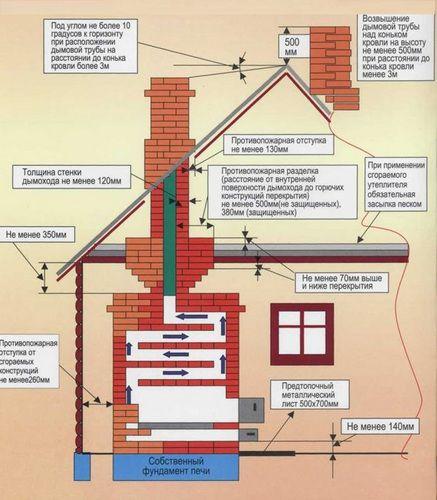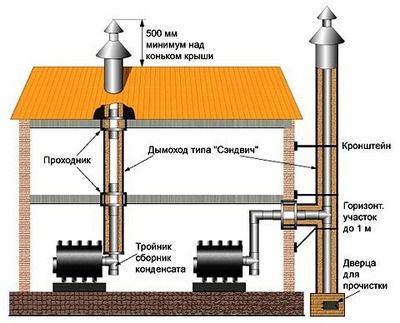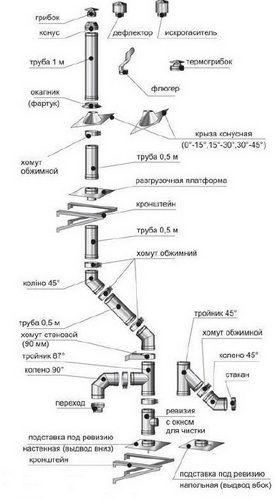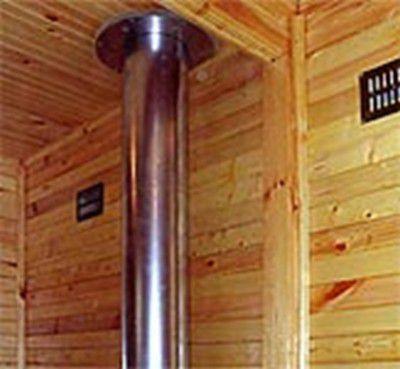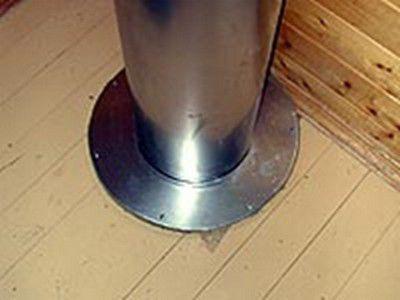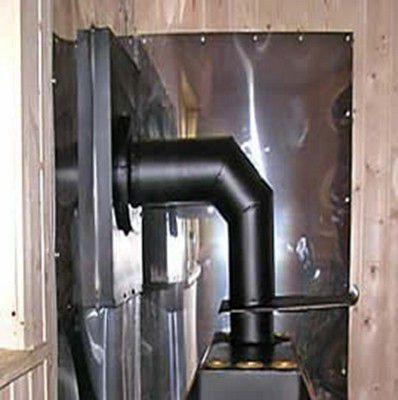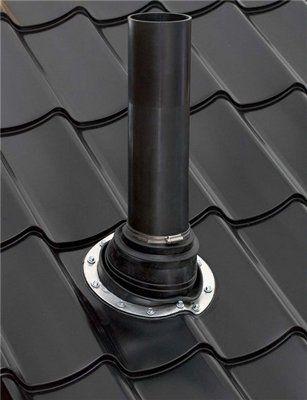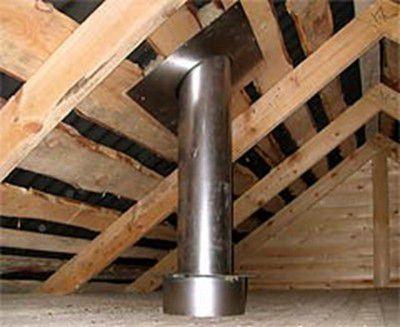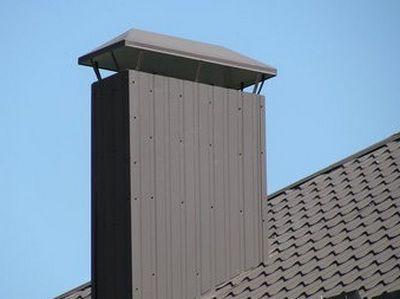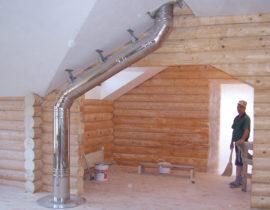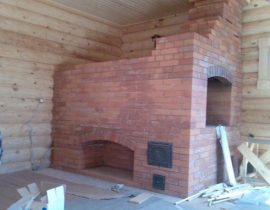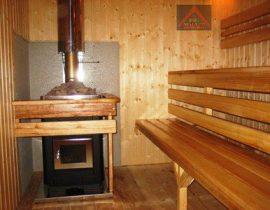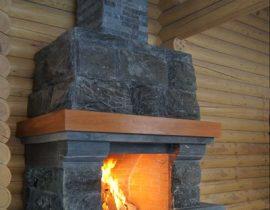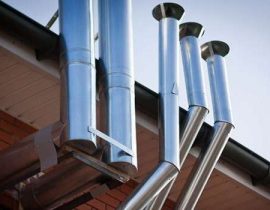One of the main components in the heating system is the smoke outlet.
Chimney device in a private house — a rather complicated and important process, since not only the proper functioning of the heater, but also the health of the residents of the house depends on the correct operation.
The functions of the chimney are to remove harmful products that are released during the combustion of fuel along with smoke, so leakage cannot be allowed, although would parts of these thingstv into the room.
Another, no less important, factor in the arrangement of the chimney is its fire safety. It is necessary to ensure its correct passage through ceilings and roofs, as well as to isolate it from walls built of combustible materials. Observing all the rules when building this heating communication, you can achieve her excellent work for many years, of course, carrying out annual preventive maintenance.
Content
Binding Rules
Everything needs to be done so to not get further problems with regulatory organizations, and also feel completely safe, and for this it is worth studying the mandatory rules and regulations for the construction and operation of chimneys for heating appliances. This is especially true of brick ovens and fireplaces.
- Bake must have its own foundation. This condition is important because this structure should not depend on other foundations of the house. In the event of shrinkage or other unforeseen movements of the soil, the skew of the common foundation can lead to a violation of the masonry not only of the furnace, but also of the chimney. The appearance of seemingly minor and imperceptible cracks may represent serious threat to the health of residents.
- The blower hole must be located at a height of at least ten centimeters from the floor, as it must provide a sufficient supply of oxygen, thereby ensuring the normal combustion of fuel and draft in the chimney.
- For fire safety purposes, the stove must be located at least 25 centimeters from the walls of the building, made of flammable materials. And the best option would be more and insulate the walls with heat-resistant materials.
- When arranging the internal structure of the furnace, where the chimney actually begins with smoke extractors channels, it is necessary to strictly observe the layout of the rows. Overlapping at least one of the channel openings can threaten the house with smoke, with all the ensuing consequences.
- The furnace body itself must be 35 meters below the ceiling.—40 centimeters. Further starts chimney pipe.
- It is very important to arrange the correct cutting of the chimney passage through the attic floor.Brick protrusions should have steps seven centimeters high before entering the ceiling and after cutting out in the attic.
- If the attic floor is insulated with combustible heaters, it is necessary to lay a layer of sand on top of them at least five - seven centimeters.
- For fire cutting in the attic, the distance from the inner wall of the chimney to combustible materials must be at least 50 cm. For this, the chimney skirt is laid out, which is located directly in the attic floor.
- The wall thickness of the brick chimney pipe should be 12—15 centimeters.
- If the pipe comes out on the roof distance more three meters from the skate horizontal, height her should be sloped from the horizon no more than 10 degrees. If the pipe is locatedon on shorter distance, it should rise above the ridge by at least half a meter.
- These rules are provided by the services by byfire safety and must be strictly observed.
Chimney for metal furnaces and boilers
Chimneys for cast iron stoves are simpler in structure and come in two types:
- The first of them, shown in the figure, is more complicated than the second in execution, since it passes through all the ceilings inside the building. Especially labor intensive there will be procedures for arranging it in the roof and waterproofing the seams around the pipe.
But the advantage of this chimney — in greater preservation of heat in the premises and in the fact that it can heat more and the second floor or attic through which the pipe will pass.
- The second option for the chimney of a metal furnace is the design, nearly running entirely along the street. Inside the house remains only her part that is fixed horizontally. It's a diversion from fromthe heating device is a segment, which can be straight or in the form of a so-called knee. It exits through the wall to the street and enters a vertical chimney that rises parallel to the wall. Such a device is safer, and the pipe is not will take extra floor space. Her arrangement will not cause trouble for waterproofing on the roof and her pass through the ceiling.
But, making such a design, a pipe for her you need to choose with a thicker heat-insulating layer, which can reach a thickness of up to 10 cm. Without such insulation, the smoke in the pipe will quickly cool down, the draft will decrease, and also Maybe the formation of condensate, which is highly undesirable for the furnace.
Details for a metal chimney
If earlier, in order to make a decent chimney, you had to tinker a lot or spend a considerable amount on an order for a tinsmith, today manufacturers of ventilation and heating systems produce finished parts of various configurations.
Such chimneys are produced for different diameters, heights and thicknesses of insulation. In addition, other accessories are also sold, which are necessary for installing a chimney system on the wall and protecting her from being hit inside moisture. An approximate list of parts intended for this purpose:
- Pipes of various lengths, equipped special locking grooves for fastening them with other parts of the structure.
- Metal corner transitions, made at different angles.
- Clamps in various sizes.
- Mounting brackets
- Floor, wall and ceiling stands and pipe fittings.
- Tees, also made at different angles.
- Deflectors, fungi, spark arresters and thermofungi.
- Connecting bends with the required range of angles.
- Other small parts needed to install the chimney.
Important components in the chimney device
It is very important to properly arrange the most complex chimney components — aisles it through the attic, interfloor ceiling, roof, and also through the wall, if the main pipe runs completely along the street.
Interfloor and attic flooring
Framing the passage of the chimney in the ceiling, made of wood, is carried out with special nozzles that isolate it from combustible materials in order to prevent their ignition. The branch pipe has a larger diameter than the pipe, so when they are connected, a gap is formed, which also helps to protect against overheating.
Chimney passage through the ceiling
There must be a distance between the chimney and the ceiling, in which it is necessary to place a foil or asbestos non-combustible material, the thickness whom must be at least 7—9 cm. Foil insulator is laid with foil inside.
It is important to remember that in the place of the passage in the ceiling, the pipe cannot have joints, but must be solid.
If it is planned to pass a pipe in the room of the upper floor, then it should be arranged around her casing, with ventilation holes through which hot air will enter the room. They are usually drilled from the top and bottom of the casing.Such protection is needed in order not to accidentally burn yourself on a very hot pipe during the heating of the furnace.
On the ceiling and on the floor of the second floor, at the place where the pipe passes through the floors, there are metal parts of the flange pipe that cover the combustible materials of the floor and ceiling.
Passage through the wall
pass chimney pipes through the wall are made in the same way as through the ceiling, using special nozzles put on the chimney, which will help isolate combustible materials from high temperatures. Also pipe section that will be in the wall, turns around heat-resistant material with a thickness of at least 7—10 cm
Passage through the roof
The most difficult place is the node of penetration through the roof of the pipe. It requires special attention in work, since the safety will depend on it. battens and insulation from external moisture, as well as the general fire safety of the house.
To do this, waterproofing is arranged around the pipe from the outside with the help of a special tape or “passage” on the flange, which are fixed to the adhesive-sealant, and screwed on top with self-tapping screws.
To prevent overheating battens, the pipe must be wrapped heat-resistant material, and from the inside of the roof pass through the metal panel.
The final step in the installation of the chimney is to install an umbrella on top of it, which will protect against inside dirt and water.
Conditions for normal operation
The design must:
- effectively remove gaseous wastes of fuel combustion;
- be safe and comfortable at home;
- have good traction;
- withstand high temperatures;
- to be protected from moisture and condensate;
- have resistance to external aggressive environment.
Chimneys can have a square and cylindrical shape, the latter is considered optimal, as it is less susceptible to the accumulation of soot and soot.
Other parameters that are also indicated by building codes:
- alloy steel parts produced for the installation of chimneys are distinguished by their anti-corrosion properties and have a thickness in in 0.5 cm;
- the size of the pipe diameter must match the size of the furnace nozzle or be slightly larger than it;
- a chimney arranged for a brick oven is equipped with pockets that are located at the bottom of the chimney channels and have a depth of 20—25 centimeters. Doors are installed on them through which soot is cleaned raid;
- a metal chimney cannot have more than 3 turns;
- the turning radius of a metal chimney cannot be greater than the diameter of the pipe;
- the pipe must have a height of at least five meters.
All these conditions will help to create normal draft in the chimney and effective removal of combustion products hazardous to health..
A small video tutorial on installing a chimney in a private house
It must be remembered that the choice of a chimney does not depend on its external data, but on the furnace on which it will be installed, as well as on the fuel used and other heating parameters. That's whybefore purchasing or constructing a chimney, you should consult a specialist.
And more one warning - for some inexperienced builders, the abundance of requirements for the arrangement of stove heating and chimneys - in particular, may seem like unnecessary "nitpicks" that you can, if desired, to not pay attention. Believe me, these rules are developed by life itself, based on centuries of experience and careful engineering. calculations. It is sad, but more than once the neglect of them has been paid for with human lives.


